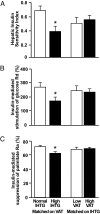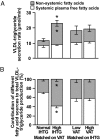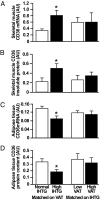Intrahepatic fat, not visceral fat, is linked with metabolic complications of obesity
- PMID: 19706383
- PMCID: PMC2741268
- DOI: 10.1073/pnas.0904944106
Intrahepatic fat, not visceral fat, is linked with metabolic complications of obesity
Abstract
Visceral adipose tissue (VAT) is an important risk factor for obesity-related metabolic disorders. Therefore, a reduction in VAT has become a key goal in obesity management. However, VAT is correlated with intrahepatic triglyceride (IHTG) content, so it is possible that IHTG, not VAT, is a better marker of metabolic disease. We determined the independent association of IHTG and VAT to metabolic function, by evaluating groups of obese subjects, who differed in IHTG content (high or normal) but matched on VAT volume or differed in VAT volume (high or low) but matched on IHTG content. Stable isotope tracer techniques and the euglycemic-hyperinsulinemic clamp procedure were used to assess insulin sensitivity and very-low-density lipoprotein-triglyceride (VLDL-TG) secretion rate. Tissue biopsies were obtained to evaluate cellular factors involved in ectopic triglyceride accumulation. Hepatic, adipose tissue and muscle insulin sensitivity were 41, 13, and 36% lower (P < 0.01), whereas VLDL-triglyceride secretion rate was almost double (P < 0.001), in subjects with higher than normal IHTG content, matched on VAT. No differences in insulin sensitivity or VLDL-TG secretion were observed between subjects with different VAT volumes, matched on IHTG content. Adipose tissue CD36 expression was lower (P < 0.05), whereas skeletal muscle CD36 expression was higher (P < 0.05), in subjects with higher than normal IHTG. These data demonstrate that IHTG, not VAT, is a better marker of the metabolic derangements associated with obesity. Furthermore, alterations in tissue fatty acid transport could be involved in the pathogenesis of ectopic triglyceride accumulation by redirecting plasma fatty acid uptake from adipose tissue toward other tissues.
Conflict of interest statement
Conflict of interest: The authors declare no conflict of interest.
Figures



Comment in
-
Nonalcoholic fatty liver disease: the hepatic trigger of the metabolic syndrome.J Hepatol. 2010 Dec;53(6):1146-7. doi: 10.1016/j.jhep.2010.06.013. Epub 2010 Aug 13. J Hepatol. 2010. PMID: 20817302 No abstract available.
References
-
- Gastaldelli A, et al. Metabolic effects of visceral fat accumulation in type 2 diabetes. J Clin Endocrinol Metab. 2002;87:5098–5103. - PubMed
-
- Vega GL, et al. Influence of body fat content and distribution on variation in metabolic risk. J Clin Endocrinol Metab. 2006;91:4459–4466. - PubMed
-
- Adiels M, et al. Overproduction of large VLDL particles is driven by increased liver fat content in man. Diabetologia. 2006;49:755–765. - PubMed
-
- Despres JP. The insulin resistance-dyslipidemic syndrome of visceral obesity: Effect on patients' risk. Obes Res. 1998;6(Suppl 1):8S–17S. - PubMed
-
- Bergman RN, et al. Why visceral fat is bad: Mechanisms of the metabolic syndrome. Obesity (Silver Spring) 2006;14(Suppl 1):16S–19S. - PubMed
Publication types
MeSH terms
Substances
Grants and funding
LinkOut - more resources
Full Text Sources
Other Literature Sources
Medical
Miscellaneous

